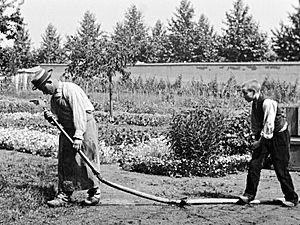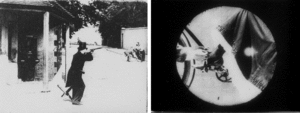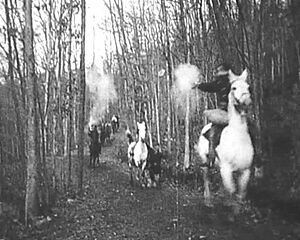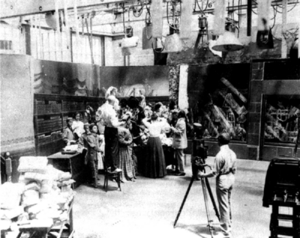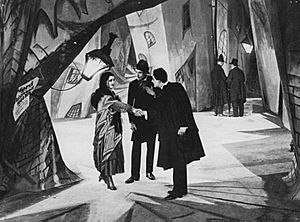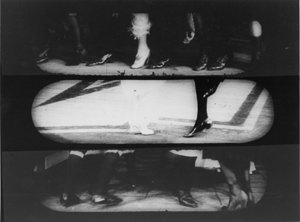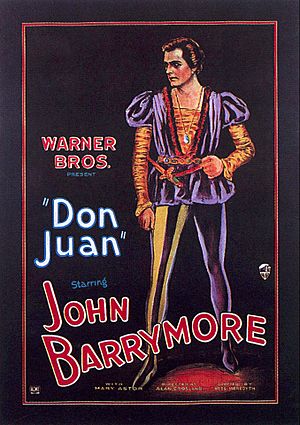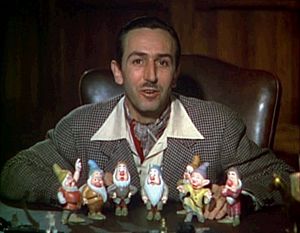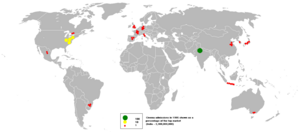History of film facts for kids
The history of film is all about how movies, a cool type of visual art, grew and changed using special film tools. It all started in the late 1800s.
It's hard to say exactly when film became an art form. But a big moment was on December 28, 1895. That's when the Lumière brothers showed ten short films to people in Paris. This was a huge step for projected movies! Others, like the Skladanowsky brothers, had shown moving pictures earlier in Berlin in November 1895. But the Lumière brothers' invention, the Cinématographe, became famous worldwide.
The very first films were black and white, less than a minute long, and had no sound. They were just one shot from a still camera. In just ten years, movies went from being a new trick to a big entertainment business. Film companies and studios popped up everywhere.
Filmmakers also started to figure out how to tell stories better. They used editing, camera movements, and other cinematic techniques to make films more exciting and clear.
New ways to watch movies came along, like television (popular since the 1950s), home video (popular since the 1980s), and the internet (popular since the 1990s). These changed how films were shared and watched. Movie makers often made films to fit these new ways. They also used new tech like widescreen (since the 1950s), 3D, and 4D film to make going to the movie theater more special.
Cheaper and easier-to-use tools, like 8mm film, video cameras, and even smartphone cameras, let more people make their own films. These could be anything from home movies to video art. The quality got much better with digital video and good, affordable digital cameras.
In the 1990s, digital ways of making movies became very popular. This led to super realistic visual effects and popular full-length computer animations. Many different film genres also appeared and became popular over time, like horror movies.
Contents
- How Movies Began
- Early Movies: A New Kind of Fun (1890s - Early 1900s)
- Movies Go Global (1900s - 1910s)
- The Roaring Twenties
- The Talkies Arrive (1930s)
- The Forties: War and New Styles
- The Fifties: TV Arrives and Movies Get Bigger
- The Sixties: New Waves and Big Musicals
- The Seventies: New Hollywood and Blockbusters
- The Eighties: Home Video and Franchises
- The Nineties: Indies, CGI, and DVDs
- The 2000s: Streaming, 3D, and Global Films
- The 2010s: Superheroes Take Over
- The 2020s: Pandemic Changes Movies
- See also
How Movies Began
Movies didn't just appear out of nowhere! They grew from older ways of telling stories and making art. Think about storytelling, literature, theatre, and visual arts.
Early Storytelling with Pictures
Long ago, people would tell stories using pictures shown one after another. This was like a very early form of film. Before modern movie cameras, people used light and shadows to create art. This included shadowgraphy (making shapes with hands), shadow puppetry, camera obscura (a dark box that projects an image), and the magic lantern.
Shadow shows were early examples of using moving pictures for fun and stories. They started in the Far East and used shadows from hands or objects to help tell tales. Shadow puppetry was popular for centuries in Asia and later came to Europe.
Magic Lanterns and Ghost Shows
By the 1500s, entertainers used camera obscura and other projection tricks to make ghostly images appear. In the late 1600s, magic lantern shows became popular. They often showed scary figures like monsters and death. Around 1790, these shows turned into "phantasmagoria," which were multimedia ghost shows. They used moving slides, smoke, sounds, and even electric shocks to scare audiences! Later, magic lantern shows became more creative and educational, appealing to families.
Moving Pictures for Science
In the 1830s, scientists like Joseph Plateau studied how spoked wheels seemed to move strangely. This led to inventions like the phenakistiscope, a spinning disk that made pictures look like they were moving. People tried to combine this with stereoscope (for 3D images) and photography to make things look even more real. But it was hard because early photos needed long exposure times.
Most early photo sequences, called chronophotography, were for science, not entertainment. They showed humans or animals doing simple movements. In 1878, photographer Eadweard Muybridge started taking many photos of animals and people moving. He later used his Zoopraxiscope to project these images, making them look animated.
In 1887, German inventor Ottomar Anschütz showed his moving photos using a device called the Elektrischen Schnellseher. By 1891, he made smaller, coin-operated versions. He filmed wrestlers, dancers, and daily life, turning moving pictures into mass entertainment. Thousands paid to see his shows.
Another inventor, Charles-Émile Reynaud, showed his "Optical Theatre" in Paris from 1892 to 1900. His device projected animated stories like Pauvre Pierrot to over 500,000 visitors.
Early Movies: A New Kind of Fun (1890s - Early 1900s)
Getting Ready for Projection
In 1889, American inventor Thomas Edison asked his assistant, William Kennedy Dickson, to create a device for visuals to go with his phonograph (record player). They built the Kinetoscope, a peep-box viewer with film loops showing about half a minute of action. Edison showed it in 1893. Many Kinetoscope films showed famous vaudeville acts. The Kinetoscope became a global hit by 1895.
But people soon got bored. Edison tried to add sound, but it was hard to sync. Other inventors started working on projecting films for larger audiences.
In late 1895, the Lumière brothers filmed short scenes with their invention, the Cinématographe. On December 28, 1895, they had their first public showing in Paris. It included ten films and lasted about 20 minutes. Most were "actuality films," showing real life, like Workers Leaving the Lumière Factory. But they also showed a funny staged film, L'Arroseur Arrosé. The Cinématographe was a huge success!
The Lumière brothers mainly wanted to sell cameras, not make films. But filmmakers everywhere were inspired. This early time, called "the cinema of attractions," was about amazing audiences with moving pictures, not just stories. Still, early story films did exist. Movies were shown in temporary shops, tents at fairs, or as part of vaudeville shows. Often, live musicians, sound effects, and a speaker would go along with the film.
Filmmakers in France, England, and the U.S. started experimenting with editing, special effects, and camera moves. In 1896, The Fairy of the Cabbages, directed by Alice Guy-Blaché, was arguably the first story film ever, and the first directed by a woman! That same year, Edison's The May Irwin Kiss was a big hit but also led to the first calls for film censorship.
Australia's Limelight Department, run by The Salvation Army from 1898, also made many films. They produced about 300 films, making them one of the biggest film producers of their time.
News and Real-Life Films
At first, movies weren't seen as art. They were cheap fun for working-class people and too short for long stories. Ads focused on the technology, not the films. As people got used to the tech, filmmakers used it to show real events, like newsreels.
The Lumière brothers sent cameramen worldwide to film new subjects. These cameramen often showed their films locally, then sent them back to France for copies to be made. Filmmakers learned new camera tricks to film unpredictable real events. Early films were often sold in groups of related subjects. Exhibitors would explain what was happening on screen.
On May 20, 1895, the first paying audience for a movie gathered to see a staged boxing fight filmed by Woodville Latham. This film used a new invention called the Latham loop, which allowed for longer movies.
In 1897, The Corbett-Fitzsimmons Fight, a full recording of a boxing match, made more money than the actual fight! It was the longest film of its time.
From 1910, regular newsreels became popular for getting the news before TV. The British Antarctic Expedition to the South Pole was filmed for newsreels, as were suffragette demonstrations. F. Percy Smith was an early nature documentary pioneer who used time lapse and micro cinematography in his 1910 film about growing flowers.
Trying Out Storytelling in Films
France: Méliès, Pathé, Gaumont

After the Cinématographe's success, the French film industry grew fast. New companies like Star Film Company, Pathé Frères, and the Gaumont Film Company appeared.
Georges Méliès is famous for narrative filmmaking. He was a magician who used magic lanterns in his acts. He saw the potential of film for his shows. After the Lumière brothers refused to sell him a camera, he bought one from Robert W. Paul and started experimenting. Méliès discovered special effects like the stop trick (making things appear/disappear), multiple exposures, and dissolves.
In 1896, Méliès started the Star Film Company and made over 500 short films. He combined his theater skills with new camera effects. He built a special stage with trapdoors to create complex stories like The House of the Devil (1896), one of the first horror films, and Cinderella (1899). Méliès kept his camera in a fixed position, like watching a play on a stage. He's best known for his 1902 film, A Trip to the Moon, which is considered the first science fiction film.
In 1900, Charles Pathé started Pathé-Frères with Ferdinand Zecca leading the creative side. Pathé-Frères quickly became the biggest film studio in the world, making many different kinds of films.
The Gaumont Film Company was Pathé-Frères' main rival. Founded in 1895 by Léon Gaumont, it started making films in 1897, led by Alice Guy-Blaché, the first female director. She made dance and travel films, like Le Boléro (1905). In 1906, she made The Life of Christ, a big production with 300 extras.
England: Paul, Hepworth, Brighton School
Cecil Hepworth and Robert W. Paul tried different camera techniques. Paul's camera (1895) could reverse film, allowing for multiple exposures, first seen in his 1901 film Scrooge, or, Marley's Ghost. They also played with camera speeds. Paul filmed On a Runaway Motor Car through Piccadilly Circus (1899) very slowly, so when played normally, the scenery looked super fast. Hepworth did the opposite in The Indian Chief and the Seidlitz Powder (1901), making movements look like "slow motion".
Early films often had single shots. It's hard to know exactly when films started having continuous scenes. But Robert W. Paul's 1898 film, Come Along, Do!, is thought to be one of the first with real film continuity. The 1901 British film Attack on a China Mission was also one of the first to show continuous action across multiple scenes.
Intertitles (text on screen) to explain actions and dialogue started in the early 1900s, first in Paul's Scrooge, or Marley's Ghost. Soon, intertitles provided dialogue and narration, meaning exhibitors didn't have to explain everything.
Filmmakers in England, known as the "Brighton School" (like George Albert Smith and James Williamson), also worked on continuous action. They were probably the first to use inserts and close-ups. Smith pioneered double exposure in Photographing a Ghost (1898) and reverse motion in films like The House That Jack Built (1900).
In 1898, George Albert Smith experimented with close-ups. In 1899, he made The Kiss in the Tunnel, which had three shots: a train entering a tunnel, a couple kissing, and the train leaving. This created a clear sequence of events. Smith also used inserts in films like Grandma's Reading Glass (1900), where a close-up shows what Grandma is reading.
James Williamson improved narrative techniques in his 1900 film, Attack on a China Mission. It showed Chinese rebels, then a missionary family fighting, and finally British sailors rescuing them. It also used the first "reverse angle" cut. In 1901, Williamson made The Big Swallow, where a man "swallows" the camera using close-ups and superimpositions. His film Stop Thief! (1901) started the "chase film" genre.
United States: Edison and Porter
Edison's 1895 film The Execution of Mary Stuart used a special effect called the stop trick. The actor was replaced with a dummy for the execution scene, making it look real. This was one of the earliest special effects in film.
Edwin Stanton Porter started making films for Edison in 1901. He was inspired by Méliès, Smith, and Williamson. Porter used their new techniques to create continuous stories through editing.
In 1902, Porter made Life of an American Fireman, combining old and new footage to tell a dramatic rescue story.
Porter's The Great Train Robbery (1903) was twelve minutes long with twenty different shots. It's seen as one of the first Western films. It was important for showing actions happening at the same time in different places. This film helped make movies super popular. That same year, the Miles Brothers opened the first "film exchange," letting theaters rent films more cheaply.
In 1905, John P. Harris opened the first theater just for films, called the nickelodeon, in Pittsburgh. This idea spread fast, and by 1908, there were about 8,000 nickelodeons across the U.S. This created a huge demand for more story films.
In 1908, Thomas Edison helped create the Motion Picture Patents Company (MPPC). This group of major film companies controlled film production and distribution. It led to better quality films and helped the American film industry grow, but it also limited the creation of longer "feature films." By 1915, the MPPC lost its power as companies started making more feature films.
Movies Go Global (1900s - 1910s)
New Countries Making Movies
As movies became popular worldwide, more countries joined Britain, France, Germany, and the U.S. in making films.
In Italy, Turin was an early film center. Ambrosio Film was the biggest company there. Their rival, Cines in Rome, started in 1906. Italian films were known for big historical epics with huge casts and sets. Films like The Fall of Troy (1911) and Quo Vadis? (1912) were very impressive. Cabiria (1914) was two and a half hours long! Italian companies also made funny slapstick comedies.
Denmark was a very important film-producing country in Northern Europe before World War I. The Nordisk company, started by Ole Olsen in 1906, made many films with exciting subjects like The White Slave (1907). By 1910, new Danish companies appeared, and actress Asta Nielsen became famous in The Abyss (1910).
The Swedish film industry grew slower. In 1909, Charles Magnusson started making fiction films. Production grew in 1912 when Victor Sjöström and Mauritz Stiller became directors. They started by copying Danish films but soon made their own unique and successful movies.
Russia started its film industry in 1908. Aleksandr Khanzhonkov's company quickly became the largest Russian film company.
In Germany, Oskar Messter had been making films since 1896. But it wasn't until Paul Davidson brought Asta Nielsen and Urban Gad from Denmark in 1911 that German films started to be rented instead of sold. This helped the industry grow.
Before World War I, American films were the most popular in most European countries, even in France. Pathé Frères helped shape the American film business, adding titles, subtitles, and posters to films for the first time.
Film Techniques Get Better
New film techniques appeared, like using artificial lights, fire effects, and Low-key lighting (making most of the scene dark) for scary parts.
Filmmakers also got better at making action flow smoothly from one shot to the next. In Pathé's le Cheval emballé (1907), they used cross cutting (showing two actions happening at the same time). David Wark Griffith also started using cross-cutting in The Fatal Hour (1908). Another new idea was the point of view shot (showing what a character sees), first used in 1910. Insert shots were also used for artistic reasons, like a snake slithering in the Italian film La mala planta (1910).
In 1909, 35mm became the standard film size worldwide.
As films got longer, special writers were hired to turn complex stories from books or plays into shorter film versions. Films started to be grouped into genres, like comedy and drama.
Intertitles with dialogue became common from 1908. By 1912, dialogue titles were inserted right into scenes, making films feel much more like today's sound films.
World War I and the Film Industry
World War I was a big time of change for movies. Films went from short one-reel programs to longer "feature films." Movie theaters became bigger and charged more.
In the U.S., many film companies struggled, but Vitagraph company was an exception. Film production started moving to Los Angeles. New companies like Jesse L. Lasky Feature Play Company and Famous Players formed. The biggest hit of these years was David Wark Griffith's The Birth of a Nation (1915), followed by Intolerance (1916). American films were very high quality and popular.
In France, film production almost stopped because of the war. Italian film production did better, but "diva films" (with sad female leads) didn't do well. In Denmark, too much production led to a sharp decline in their film industry.
The German film industry was also weakened by the war. Joe May made thrillers, and Ernst Lubitsch became famous for comedies and dramas.
New Film Techniques Emerge
Studios started using floodlights and spotlights instead of relying on sunlight. A new technique called "irising-in and out" became popular. This is when a circular mask slowly reveals or hides a scene.
"Soft focus" (making parts of the image slightly blurry for artistic effect) started in 1915, seen in films like Mary Pickford's Fanchon the Cricket.
Camera effects that showed what characters were feeling or seeing (Point of View shots) became more common.
Symbolic effects, like showing a spider and ants to represent an "evil thought" in D. W. Griffith's The Avenging Conscience (1914), also appeared.

Insert shots (close-ups of objects, not just faces) became more common after 1914. Griffith's The Avenging Conscience used many close-ups of hands and feet to show tension.
"Atmospheric inserts" developed in Europe in the late 1910s. These are shots that don't show characters but set the mood. For example, in The Pride of the Clan (1917), shots of waves crashing showed the hard lives of fishing people.
By 1914, "continuity cinema" (making scenes flow smoothly) was standard. Cutting to different angles within a scene became common in American films. Ralph Ince helped develop "reverse-angle cutting," where the camera angle changes by more than ninety degrees.
Flashbacks also developed, usually starting and ending with a dissolve. The The Man That Might Have Been (1914) used many flashbacks to show what a character's life could have been like.
After 1914, cross cutting between parallel actions was used more, especially in American films, to create contrast.
Silent films often used film tinting to add color. Amber meant daytime, blue meant dawn or night, red meant fire, green meant mystery, and brown (sepia) was for full-length films. Famous examples include The Birth of a Nation and The Cabinet of Dr. Caligari.
The Photo-Drama of Creation (1914) was one of the first to use synchronized sound, moving film, and color slides. Until 1927, most movies were silent. This time is called the silent era.
Film as Art
The main trend in cinema, led by the U.S., was to use new film techniques to tell stories and combine them with traditional theater styles. David Wark Griffith was highly respected for the drama in his films. Cecil B. DeMille's The Cheat (1915) explored moral problems in a subtle way. Maurice Tourneur was known for beautiful films and realistic acting.
Sidney Drew developed "polite comedy," while Fatty Arbuckle and Charles Chaplin refined slapstick comedy. They slowed down the fast pace of other comedies to let audiences enjoy their clever movements and gags. By 1917, Chaplin also added more drama and emotion to his films.
In Russia, Yevgeni Bauer made unique films with slow, intense acting and symbolic meanings. In Sweden, Victor Sjöström made films that showed real life and nature, while Mauritz Stiller created sophisticated comedies.
In Germany, Ernst Lubitsch was inspired by theater and applied it to his films, like The Doll and The Oyster Princess.
The Roaring Twenties
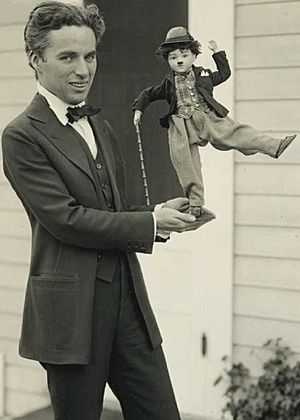

At the start of World War I, French and Italian movies were the most popular globally. The war greatly disrupted European film industries.
Throughout the early 1900s, filmmakers learned how to use cameras to create illusions with space and time. This led to new stars like David W. Griffith. In the 1920s, two big changes happened: sound came to movies, and the "studio system" began. Talented people started working together in studios. In 1927, The Jazz Singer was released, bringing sound to movies.
German cinema saw the rise of German Expressionist films. Berlin, with its Studio Babelsberg, was the center. These films used strange, non-realistic sets with odd angles and painted designs to make up for small budgets. Their stories often dealt with madness and betrayal, reflecting the experiences of World War I. Films like The Cabinet of Dr. Caligari (1920), Nosferatu (1922), and M (1931) had a huge impact.
Movies like Metropolis (1927) and Woman in the Moon (1929) helped create the science fiction film genre. Lotte Reiniger was a pioneer in animation, making animated feature films like The Adventures of Prince Achmed, the oldest surviving animated movie from Europe.
Many German directors, actors, and writers moved to the U.S. when the Nazis came to power. This helped Hollywood become the world's leading film producer.
The American film industry, or "Hollywood" (named after its new center in California), became the world's movie factory. By the 1920s, the U.S. made about 800 feature films each year, which was 82% of all films globally. The comedies of Charlie Chaplin and Buster Keaton, the adventures of Douglas Fairbanks, and the romances of Clara Bow made them famous everywhere.
The "studio system" and "star system" grew, where studios controlled all parts of filmmaking and created famous movie stars. This allowed for lavish productions but also limited daring and unique films.
In 1924, Sam Goldwyn, Louis B. Mayer, and Metro Pictures created MGM.
The Talkies Arrive (1930s)
The Sound Era Begins
In late 1927, Warner Bros. released The Jazz Singer. It was mostly silent but had the first synchronized dialogue and singing in a feature film. However, Charles Taze Russell's The Photo-Drama of Creation (1914) actually used synchronized sound (records) with pictures earlier. Early sound systems like Vitaphone (sound-on-disc) were soon replaced by sound-on-film methods. This convinced everyone that "talking pictures," or "talkies," were the future. In 1926, Warner Bros. also released Don Juan with synchronized sound effects and music.
The change was incredibly fast. By the end of 1929, Hollywood was almost all talkies. The change was slower in other parts of the world, mainly because it was expensive. In countries like China and Japan, silent films continued to be popular into the 1930s.
Sound made major studios even more powerful because the cost of the change was too much for smaller companies. In the U.S., some historians say sound saved Hollywood during the Great Depression. This began the "Golden Age of Hollywood," from the late 1920s to the late 1940s. American cinema became known for its glamour and global appeal. Stars like Clark Gable, Katharine Hepburn, Humphrey Bogart, Greta Garbo, and child star Shirley Temple became legends.
How Sound Changed Movies
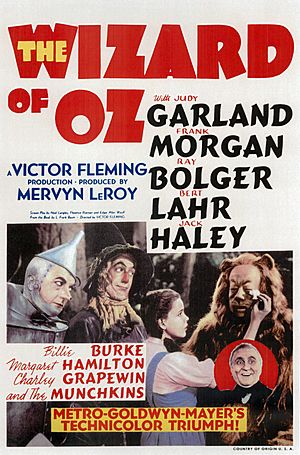
At first, adding sound was hard. Films became more static, like stage plays, as filmmakers learned how to use the new equipment. Many stage actors, directors, and writers came to Hollywood. Some silent film stars and directors couldn't adapt, and their careers ended.
But this awkward period didn't last long. By 1929, directors like William Wellman, Rouben Mamoulian, and Alfred Hitchcock made talkies more fluid and experimented with sound. They benefited from better microphones, cameras, and ways to edit sound.
Sound films helped different genres grow. The musical film was born with The Broadway Melody (1929). Busby Berkeley became a famous musical director. In France, René Clair used songs and dances in comedies like Under the Roofs of Paris (1930). Universal Pictures released gothic horror films like Dracula and Frankenstein (both 1931). In 1933, RKO Pictures released King Kong. In India, musicals became the main type of film, influenced by traditional song-and-dance dramas.
American gangster films like Little Caesar and The Public Enemy (both 1931) became popular. Dialogue became more important than slapstick in comedies. Walt Disney made the first English-speaking animated feature, Snow White and the Seven Dwarfs, in 1937. 1939 was a big year for American cinema, with films like The Wizard of Oz and Gone with The Wind.
Color Comes to Cinema
About 80% of films from the 1890s to the 1920s had colors. Many were tinted with dyes, some were hand-painted, and since 1905, there was a machine process called Pathécolor.
Kinemacolor was the first successful commercial color process, making films in two colors (red and cyan) from 1908 to 1914.
Technicolor's natural three-strip color process was a big success in 1932 with Walt Disney's animated short "Flowers and Trees". Technicolor was first used mainly for musicals like "The Wizard of Oz", costume films, and animation. After television became popular in the 1950s, color became standard for movies in theaters.
The Forties: War and New Styles
World War II and Its Aftermath
World War II led to many films being made for propaganda. In Britain, realistic war dramas like 49th Parallel (1941) and In Which We Serve (1942) were popular. Disney made more animated features like Pinocchio (1940) and Dumbo (1941).
In the U.S., films also promoted patriotism and propaganda, like Mrs. Miniver (1942) and Objective, Burma! (1945). Other notable films included the anti-Nazi Watch on the Rhine (1943) and the very popular Casablanca (1942) with Humphrey Bogart. Bogart also starred in The Maltese Falcon (1941), an early film noir classic. In 1941, Orson Welles' Citizen Kane was released. It's often called the greatest film ever and changed how stories were told in movies.
The war also brought interest in fantasy films, like Britain's Gainsborough melodramas and horror films produced by Val Lewton, such as Cat People. "Women's pictures" like Now, Voyager were also very popular.
In 1946, RKO Radio released It's a Wonderful Life directed by Frank Capra. Films like The Best Years of Our Lives were inspired by soldiers returning from the war. The Actors Studio was founded in 1947, a famous acting school.
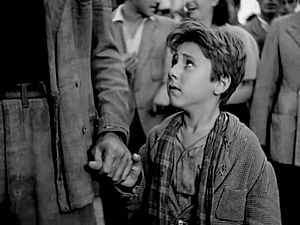
In 1943, Ossessione in Italy started Italian neorealism, a style of film that showed real life, often with non-professional actors. Major films of this type in the 1940s included Bicycle Thieves, Rome, Open City, and La Terra Trema.
In the late 1940s, Britain's Ealing Studios made famous comedies like Whisky Galore!. Carol Reed directed thrillers like The Third Man. David Lean became a world-famous director with Brief Encounter and his Dickens adaptations like Great Expectations.
The Fifties: TV Arrives and Movies Get Bigger
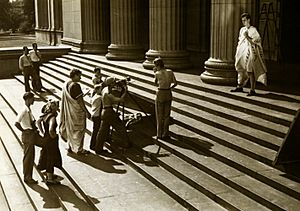
In the early 1950s, the House Un-American Activities Committee investigated Hollywood. This led to many actors, writers, and directors being "blacklisted" (meaning they couldn't work), including Charlie Chaplin. Many moved to Europe.
The Cold War era also influenced films, with themes like alien invasions (Invasion of the Body Snatchers) and spies.
After the war, movies faced a new threat: television. TV became very popular, and some movie theaters closed. Films like Sunset Boulevard (1950) showed Hollywood looking at itself.
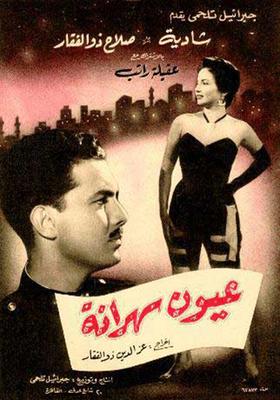
To bring audiences back, studios tried new things. They used wider screen formats like Cinemascope (first with The Robe in 1953) and VistaVision. This led to a revival of epic films, like The Ten Commandments (1956) and Ben-Hur (1959), which looked amazing on the big screen.
Gimmicks also appeared, like 3-D films (1952–1954), which helped sell House of Wax. Producer William Castle used tricks like "Emergo" (a skeleton flying over the audience) to market his films.
In 1954, Dorothy Dandridge was the first black woman nominated for Best Actress at the Oscars for Carmen Jones.
In the U.S., films started to question society, reflecting the early civil rights movement. Examples include Blackboard Jungle (1955) and 12 Angry Men (1957). Disney continued making animated films like Cinderella (1950) and Sleeping Beauty (1959), and also made live-action classics like 20,000 Leagues Under the Sea (1954).
Golden Age of Asian Cinema
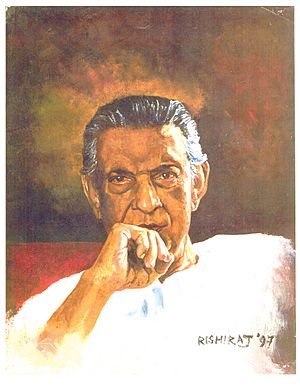
The 1950s was a "golden age" for non-English films, especially in Asian cinema. Many highly praised Asian films were made, including Yasujirō Ozu's Tokyo Story (1953), Satyajit Ray's The Apu Trilogy (1955–1959), and Akira Kurosawa's Rashomon (1950) and Seven Samurai (1954).
Japanese cinema had its 'Golden Age' with films like Godzilla (1954). Kurosawa's Seven Samurai has been remade many times, like The Magnificent Seven (1960). The Hidden Fortress (1958) inspired George Lucas' Star Wars.
Indian cinema was making 200 films annually. Satyajit Ray's The Apu Trilogy influenced many directors worldwide. Indian filmmakers also created the "Masala" genre, combining action, comedy, drama, romance, and music. Sholay (1975) was one of the most popular Indian films ever.
The cinema of South Korea also had a 'Golden Age' in the 1950s, with films like Chunhyang-jon (1955) and Yangsan Province (1955). South Korean films started winning international awards.
The 1950s was also a 'Golden Age' for Philippine cinema, with more artistic films and better techniques.
The Sixties: New Waves and Big Musicals
In the 1960s, the old Hollywood studio system started to decline. Many films were made in other countries. Hollywood films were still often for families, and big musicals like Mary Poppins (1964) and The Sound of Music (1965) were huge hits. Independent filmmakers and powerful actors also contributed to the change.
People in America became more aware of foreign films. The French New Wave directors like François Truffaut and Jean-Luc Godard made films like The 400 Blows and Breathless, which broke Hollywood's traditional rules. Italian films by Federico Fellini and Swedish dramas by Ingmar Bergman also gained attention.
In Britain, "Free Cinema" led to realistic dramas like Saturday Night and Sunday Morning.
Ousmane Sembène became the "father" of African Cinema, making films in French and Wolof. In Latin America, filmmakers challenged the Hollywood model.
In Egypt, the golden age of Egyptian cinema continued, with many productions from directors like Ezz El-Dine Zulficar and Youssef Chahine.
The fear of nuclear war also influenced films. Stanley Kubrick's Dr. Strangelove (1964) and Fail Safe (1964) were made in Hollywood, which used to be known for patriotic war films.
In documentary film, "Direct Cinema" (an observational style) became popular. By the late 1960s, Hollywood filmmakers started making more daring films that reflected social changes, like Bonnie and Clyde (1967), The Graduate (1967), and 2001: A Space Odyssey (1968). Bonnie and Clyde is often seen as the start of "New Hollywood".
In Japanese cinema, Akira Kurosawa's Yojimbo (1961) influenced films worldwide, including Sergio Leone's A Fistful of Dollars (1964).
The Seventies: New Hollywood and Blockbusters
The "New Hollywood" period followed the decline of the old studio system and the end of the strict "production code" (replaced by the MPAA rating system in 1968). In the 1970s, films showed more graphic violence, like The Last House on the Left (1972).
"Post-classical cinema" meant new ways of storytelling. Stories might jump around in time, have surprising "twist endings," or feature main characters who weren't clearly good or bad. This style started in the 1940s and 1950s with film noir and films like Hitchcock's Psycho (1960). In 1971, controversial films like A Clockwork Orange and Dirty Harry sparked debates about violence in movies.
A new group of American filmmakers emerged, including Martin Scorsese, Francis Ford Coppola, George Lucas, and Steven Spielberg. The idea of the "auteur" (a director whose films show their personal vision) became popular. This gave directors more control. It led to big hits like Scorsese's Taxi Driver, Coppola's The Godfather films, and Lucas's Star Wars. But it also led to some expensive failures.
The huge success of Spielberg's Jaws (1975) started the idea of the modern "blockbuster" film. Star Wars (1977) was revolutionary with its special effects, sound, and music. It became one of the most important and influential films ever. Hollywood studios started focusing on making fewer, very expensive films with huge marketing campaigns.
In world cinema, martial arts films became super popular, thanks to Bruce Lee. He brought more realism to Chinese martial arts films with his Jeet Kune Do style. The Big Boss (1971) was a hit in Asia, and Enter the Dragon (1973) made him famous worldwide. After Bruce Lee's death, there were many "Bruceploitation" films. But in 1978, Jackie Chan's martial arts comedies like Drunken Master brought new life to Hong Kong action cinema.
While musicals declined in Hollywood, they grew in cinema of India. The term "Bollywood" was coined for the growing Hindi film industry in Mumbai. Hindi filmmakers combined Hollywood musicals with Indian theater to create the "Masala" genre, which mixed action, comedy, drama, romance, and song-and-dance numbers. Sholay (1975) was the most popular Indian film ever.
The late 1970s also saw Australian cinema gain international attention with films like Peter Weir's Picnic at Hanging Rock and George Miller's action film Mad Max (1979).
The Eighties: Home Video and Franchises
In the 1980s, more people started watching movies at home on their VCRs. Film studios tried to ban VCRs, but they failed. Soon, selling and renting films on home video became a big new way for films to make money.
The Lucas–Spielberg team dominated Hollywood. Sequels became common, with more Star Wars films, Jaws sequels, and Indiana Jones movies. Lucas also started THX Ltd for better sound. Spielberg had a huge hit with E.T. the Extra-Terrestrial (1982). That same year, Disney's Tron was one of the first major films to use a lot of computer graphics.
American independent cinema struggled, but Martin Scorsese made acclaimed films like Raging Bull (1980). Scarface (1983) was very profitable for Al Pacino. Tim Burton's Batman (1989) broke box-office records, with Jack Nicholson earning a lot for playing the Joker.
British cinema got a boost from Goldcrest Films, which made films like Chariots of Fire and Gandhi. Hollywood started releasing films in more theaters at once. While multiplex cinemas didn't show more unique films, home video gave overlooked films a second chance.
Japanese cinema saw a revival in the 1980s, mainly due to anime films. Space Battleship Yamato and Mobile Suit Gundam became huge hits as films. Studio Ghibli was founded, producing Hayao Miyazaki's fantasy films like Nausicaä of the Valley of the Wind (1984) and Castle in the Sky (1986). Akira (1988) became an international success.
Hong Kong action cinema also revived, thanks to Jackie Chan. He combined comedy, martial arts, and dangerous stunts in films like Project A (1983) and Police Story (1985). Other trends included "girls with guns" films and "heroic bloodshed" films by John Woo, which influenced Hollywood action films later.
The Nineties: Indies, CGI, and DVDs
The early 1990s saw successful independent films in the U.S. While special-effects films like Terminator 2: Judgment Day (1991), Jurassic Park (1993), and Titanic (1997) dominated, independent films like Quentin Tarantino's Reservoir Dogs (1992) also did very well.
The Danish film movement Dogme 95 created a manifesto to "purify" filmmaking, and their first films were praised worldwide.
Scorsese's Goodfellas (1990) is considered one of the greatest gangster movies ever.
Major American studios started their own "independent" companies to make non-mainstream films. Miramax Films, a successful independent studio, was bought by Disney before Tarantino's hit Pulp Fiction (1994). That same year, film and video started being distributed online.
Animated films for families became popular again, with Disney's Beauty and the Beast (1991) and The Lion King (1994). In 1995, Pixar Animation Studios released Toy Story, the first full-length computer-animated feature. After its success, computer animation became the main way to make animated films, allowing other studios like DreamWorks and Warner Bros. to compete with Disney.
In the late 1990s, movies began to shift from physical film to digital cinema technology. DVDs also became the new standard for home video, replacing VHS tapes.
The 2000s: Streaming, 3D, and Global Films
Since the late 2000s, streaming media platforms like YouTube let anyone with a camera and internet publish videos. To compete with video games and other home entertainment, movie theaters made films more attractive with new 3D technologies and epic fantasy and superhero films.
Documentary films also became commercially successful, with films like March of the Penguins and Michael Moore's Fahrenheit 9/11. A new genre was created with Voices of Iraq, where ordinary people in Iraq were given cameras to make a collaborative film. The success of Gladiator led to a revival of epic cinema, and Moulin Rouge! renewed interest in musical cinema.
In 2001, the Harry Potter film series began. By 2011, it was the highest-grossing film franchise ever, until the Marvel Cinematic Universe passed it in 2015.
More films were released in IMAX cinemas. Treasure Planet (2002) was the first Disney animation in IMAX, and The Matrix Revolutions (2003) was the first live-action film. Later, The Dark Knight (2008) was one of the first major films partly shot with IMAX cameras.
Cinema became more global. Foreign-language films gained popularity in English-speaking countries, like Crouching Tiger, Hidden Dragon (Mandarin), Amélie (French), and Spirited Away (Japanese).
In 2003, 3D films became popular again with James Cameron's Ghosts of the Abyss, filmed with a new 3D camera system. After Cameron's 3D film Avatar became the highest-grossing film of all time, many other films were released in 3D, especially animated ones like Despicable Me and How To Train Your Dragon. Avatar also pioneered advanced motion capture technology.
The 2010s: Superheroes Take Over
By 2011, the biggest film industries by number of films made were India, the United States, China, Nigeria, and Japan.
In 2010, Kathryn Bigelow became the first woman to win the Best Director Oscar for The Hurt Locker.
In Hollywood, superhero films became extremely popular and successful. Films based on Marvel and DC comics are released regularly. By 2019, the superhero genre was the most dominant in American box office sales. The 2019 superhero film Avengers: Endgame became the highest-grossing movie of all time.
In 2020, Parasite became the first international film to win the Academy Award for Best Picture.
The 2020s: Pandemic Changes Movies
COVID-19 Pandemic
The COVID-19 pandemic caused movie theaters worldwide to close. Many films that were supposed to be released in the early 2020s were delayed in making, producing, and distributing. Some were released directly on streaming services instead of in theaters.
|
See also
 In Spanish: Historia del cine para niños
In Spanish: Historia del cine para niños


